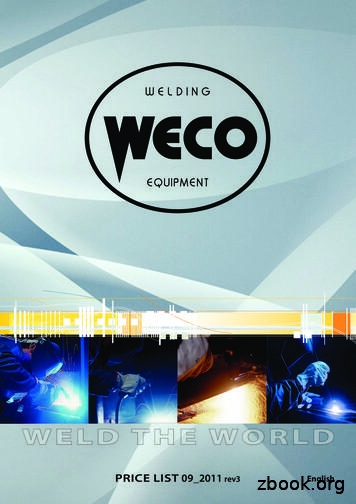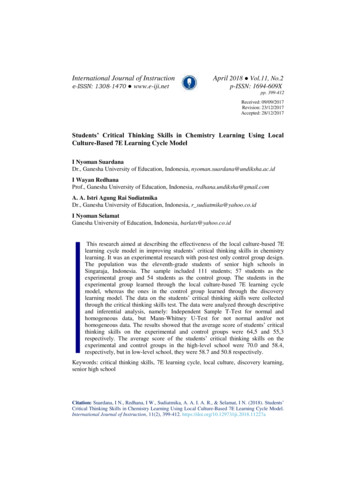Esi4u (410)-867-6262 Discovery Environmental .
www.esi4u.com (410)-867-6262Discovery Environmental Inspection ReportProject Contact InformationAlex BaylorEnvironmental SpecialistsEnvironmental Safety Office13306 Old Marlboro PikeUpper Marlboro, MD 20772301-952-6760alex.baylor@pgcps.orgJohn H. BayneElementary School49,779 square feetBryan HarringtonCertified Indoor EnvironmentalistEnvironmental Solutions, Inc.6114 Drum Point RdDeale, MD 20751410-867-6262Bryan@esi4u.comProperty Location7010 Walker Mill Road, Capitol Heights, MD 20743Date of Inspection 3/11/2019Prepared By: Bryan HarringtonCertified Indoor Environmentalist (CIE)
Dear Mr. Baylor,The results of the inspection and testing performed at John H. Bayne Elementary School, which is locatedat 7010 Walker Mill Road, Capitol Heights, MD 20743, are concluded and the findings are enclosed. Iwant to thank you for allowing ESI the opportunity to service your indoor environmental needs. Includedin this report are the observations, lab results, and recommendation from ESI’s 3/11/2019 inspection andtesting.Background InformationThe Prince George’s County Public School Environmental Team has taken a proactive approach incleaning the above-mentioned school to ensure there are no health or environmental risks related tomicrobial hazards. Historically, elevated levels of humidity, condensation from pipes, periodic steamleaks, and outdated HVAC systems may have contributed to water damage ceiling tiles and colonizationof mold spores in various areas of the school.PurposeESI was engaged to inspect the school in a random sufficient manner. Classrooms, administration officesand common area building materials and contents, will be visually inspected for water damage andmicrobial growth.In each location inspected, the indoor air quality will be tested for elevated levels of carbon monoxideand carbon dioxide, in addition to measuring the relative humidity and temperature. Microbial hazardswithin the breathable airspace will also be tested.Based upon the visual assessment, instrument readings and lab results, ESI will determine if additionalremediation in required.Observations and instrument readingsThe following table is designed for this project. You will notice either a ‘YES’ or ‘NO’ in the table.‘YES’ indicates water damage and/or suspected microbial growth was detected and ‘NO’ indicates itwas not. If ‘YES’ is noted, remediation recommendation will be included for the area inspected. Pleasenote, the cubic feet of air per room is an approximate number.
LocationRoom 103IAQSample #2378162SwabR/HN/A17.0IAQSample #2378160SwabR/HN/A28.9TempCO2COCubic feet of air.77.97670009,610InspectedCeilingWallsTeachers Children’s Tables Cabinets 2’CMU126514101NONONONONONONONONOObservation Notes There were no signs of visible mold growth in this location. The indoor air quality should not pose environmental or exposure risks at these levels. The totalspore count was 760 Count/M3 and no elevated levels of Carbon monoxide or Carbon dioxide weredetected.RecommendationsNONELocationRoom 108TempCO2COCubic feet of air.76.472800010,370InspectedCeilingWallsTeachers Children’s Tables Cabinets 2’CMU111111101NONONONONONONONONOObservation Notes There were no signs of visible mold growth in this location. Discolorations on the underside of the rectangular tables was found to be cosmetic damage to thefinish. The indoor air quality should not pose environmental or exposure risks at these levels. The totalspore count was 720 Count/M3 and no elevated levels of Carbon monoxide or Carbon dioxide weredetected.RecommendationsNONE
LocationRoom 209IAQSample #2378163SwabR/H23.624.4IAQSample #2378161SwabR/HN/A19.5TempCO2COCubic feet of air.74.87440009,607.5InspectedCeilingWallsTeachers Children’s Tables Cabinets 2’CMU125214101YESNONONONONONONONOObservation Notes There were 8-10 water damaged ceiling tiles in rear left corner of room, along the exterior wall. The indoor air quality should not pose environmental or exposure risks at these levels. The totalspore count was 240 Count/M3 and no elevated levels of Carbon monoxide or Carbon dioxide weredetected.Recommendations Remove the water damaged ceiling tiles and place in contractor’s bag for disposal. Replace ceilingtiles as needed.LocationRoom 206TempCO2COCubic feet of air.74.66750009,455InspectedCeilingWallsTeachers Children’s Tables Cabinets 2’CMU125311101NONONONONONONONONOObservation Notes There were no signs of visible mold growth in this location. The indoor air quality should not pose environmental or exposure risks at these levels. The totalspore count was 680 Count/M3 and no elevated levels of Carbon monoxide or Carbon dioxide weredetected.RecommendationsNONE
LocationRoom 201IAQSample #2378157SwabIAQSample #2378158SwabR/HTempCO2COCubic feet of air.76.26400009,610InspectedCeilingWallsTeachers Children’s Tables Cabinets 2’CMU128415101NONONONONONONONONOObservation Notes There were no signs of visible mold growth in this location. The indoor air quality should not pose environmental or exposure risks at these levels. The totalspore count was 120 Count/M3 and no elevated levels of Carbon monoxide or Carbon dioxide weredetected.RecommendationsNONELocationOutdoor 21.3R/HTempCO2COCubic feet of air.N/A12.559.7399000N/AObservation NotesThe total spore count was 2,520 Count/M3 with the prominent genus being Aspergillus/Penicilliumat 2,280 Count/M3.Carbon monoxide recorded at 000 ppm.Carbon dioxide recorded at 399 ppm.Interpretation of Lab ResultsIn the enclosed Air Cassette Analysis report, you will notice Fungal Identification, which is the generadetected in the breathable airspace, both indoors and/or outdoors (control sample). The Raw Count isthe actual number of spores counted on the slide, and the Count/M3 are the spores per cubic meter of air.The Other particles are non-living particles such as dander, mycelial fragments, pollens, etc.In order for humans to be exposed indoors, fungal spores, fragments, or metabolites must be releasedinto the air and inhaled, physically contacted (dermal exposure), or ingested. Whether symptoms developin people exposed to fungi depends on the nature of the fungal material (e.g., allergenic, toxic, orinfectious), the amount of exposure, and the susceptibility of exposed persons.Susceptibility varies with genetic predisposition (e.g., allergic reactions do not always occur in allindividuals), age, state of health, and concurrent exposures.
Air Sampling Lab Results
Conclusions/RecommendationsThe inspected locations were free of any visible mold growth or heavy accumulations of dust/debris. Noelevated levels of airborne mold spores, Carbon monoxide, or Carbon dioxide were detected in theinspected rooms.The water damaged ceiling tiles in Room 209 should be properly removed and discarded. After which,new ceiling tiles can be installed as needed.I hope you found our service beneficial. If you have any questions or concerns, please feel free to contactme at 410-867-6262.Respectfully,Bryan Harrington (CIE)Environmental Solutions, Inc.
Industry ReferencesSince the 1993 New York City Department of Health (NYCDOH) document (Assessment andremediation of Stachybotrys Atra in Indoor Environments) was produced, several other guidancedocuments have been written. This report was developed in accordance with and including: Fungal Contamination in Buildings: A Guide to Recognition and Management (Health Canada,1995). Control of Moisture Problems Affecting Biological Indoor Air Quality (Flannigan and Morey,1996). Bioaerosols: Assessment and Control (American Conference of Government IndustrialHygienists [ACGIH], 1999). Guidelines on Assessment and Remediation of Fungi in Indoor Environments (NYCDOH, 2000).[external link] Mold Remediation in Schools and Commercial Buildings (U.S. EPA, 2001). Report of the Microbial Growth Task Force (The American Industrial Hygiene Association,2001). Fungal Contamination: A manual for investigation, remediation and control (BECi) 2005. 29 CFR 1910, Occupational Safety and Health Standards for General Industry, U.S. Departmentof Labor Institute of Inspection, Cleaning and Restoration Certification Standard IICRC S520 29 CFR1926, Occupational Safety and Health Standards for the Construction Industry, U.S. Departmentof Labor 40 CFR 61, National Emission Standards for Hazardous Air Pollutants (NESHAP), U.S.Environmental Protection Agency ACR 2006, Assessment, Cleaning and Restoration of HVAC Systems, National Air Duct CleanersAssociation, 2006* ASHRAE Standards 62.1 or 62.2 ASTM D-1653, Standard Test Methods for Water Vapor Transmission of Organic Coating Films Bioaerosols: Assessment and Control, American Conference of Governmental IndustrialHygienists, 1999 Field Guide for Determination of Biological Contaminants in Environmental Samples, AmericanIndustrial Hygiene Association, 2005 A Guide for Mold Remediation in Schools and Commercial Buildings, US EnvironmentalProtection Agency, 2001 Protecting the Built Environment: Cleaning for Health, Michael A.Berry Ph.D., 1993 IICRC S100 Standard and Reference Guide for Professional Carpet Cleaning, Fourth Edition,Institute of Inspection, Cleaning and Restoration Certification, (S100)* IICRC S300 Standard and Reference Guide for Professional Upholstery Cleaning, First Edition,Institute of Inspection, Cleaning and Restoration Certification, (S300)* ANSI/IICRC S500 Standard and Reference Guide for Professional Water Damage Restoration,Third Edition, Institute of Inspection, Cleaning and Restoration Certification, (S500)*
IICRC S300 Standard and Reference Guide for Professional Upholstery Cleaning, First Edition, Institute of Inspection, Cleaning and Restoration Certification, (S300)* ANSI/IICRC S500 Standard and Reference Guide for Professional Water Damage Restoration,
6262 (or 6262-212) features individual PRESENCE controls for the LEAD and CLEAN channels. 5 This is the VOLUME control that lets you adjust the volume level of the LEAD channel. 6 This is the VOLUME control that lets you adjust the volume level of the CLEAN channel. 7 The passive TREBLE control adjusts the upper frequency range. The 6262 (and .
KSC Occupational Health Facility (OHF) 867-3347 KSC Weather 853-8484 KSC Safety Incident Reporting 867-6551 Hurricane Control Center 867-9200 Hurricane Status Center (Recording) 861-7900 LMSSC Environmental, Safety & Health Occupational Safety & Health 867-8008 or 867-8082 Environmental 867-5051
Title: Cisco_pass4lead_300-410_2021-04-22_by_Nil_145 Author: pass4lead Subject: Cisco_pass4lead_300-410_2021-04-22_by_Nil_145 Keywords: Latest Cisco exams,latest 300-410 dumps,300-410 pdf,300-410 vce,300-410 dumps,300-410 exam questions,300-410 new questions,300-410 actual
Title: Cisco_pass4itsure_300-410_2021-04-06_by_benz_133 Author: pass4itsure Subject: Cisco_pass4itsure_300-410_2021-04-06_by_benz_133 Keywords: Latest Cisco exams,latest 300-410 dumps,300-410 pdf,300-410 vce,300-410 dumps,300-410 exam questions,300-410 new questions,300-410 actual
Bon Secours Balt. Health System Joanna Pi-Sunyer 410.362.3244 410.362.3443 Broadway Services Barbara Pettit 410.563.6956 410.563.6960 Brown Capital Management Charlene Gross 410.837.3243 410.837.6525 Cangene bioPharma Charity Brown 410.843.5000 410.332.7532 Catalyst IT Services, Incor
PRICE LIST 09_2011 rev3. English. 2 Price list 09_2011. 3. MMA. Discovery 150TP - Multipower 184. 4 Discovery 200S - Discovery 250: 5 Discovery 400 - Discovery 500: 6: TIG DC: Discovery 161T - Discovery 171T MAX 7: Multipower 204T - Discovery 220T 8: Discovery 203T MAX - Discovery 300T 9: Pioneer 321 T 10:
To install the cFP-DO-410, refer to Figure 2 and complete the following steps: 1. Align the captive screws on the cFP-DO-410 with the holes on the backplane. The alignment keys on the cFP-DO-410 prevent backward insertion. 2. Press firmly to seat the cFP-DO-410 on the backplane. 1 I/O Module
guided inquiry teaching method on the total critical thinking score and conclusion and inference of subscales. The same result was found by Fuad, Zubaidah, Mahanal, and Suarsini (2017); there was a difference in critical thinking skills among the students who were taught using the Differentiated Science Inquiry model combined with the mind























